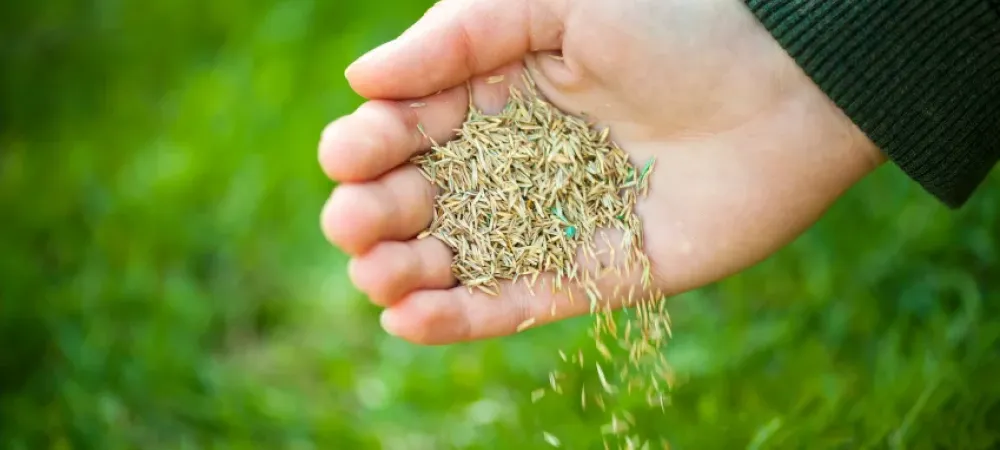Lawn Fertilization Tips for New Homeowners in Ohio

As a new homeowner in Ohio, one of the best ways to enhance your property’s curb appeal is by maintaining a beautiful lawn. A lush, green yard can increase your home’s value, improve your outdoor space, and create a welcoming atmosphere. One of the most important tasks in keeping your lawn healthy is fertilization. But don’t worry—fertilizing your lawn is easier than it sounds. In this guide, we’ll walk you through everything you need to know to fertilize your Ohio lawn successfully, with simple steps and helpful tips.
Step 1: Understand Ohio's Climate and Grass Types
Ohio has a mix of warm and cold seasons, and the best type of grass for most lawns here is cool-season grass, like Kentucky Bluegrass, Fescue, and Ryegrass. These grass varieties thrive in Ohio’s climate, especially in the spring and fall.
- Cool-Season Grasses: Grow best when temperatures are between 60°F to 75°F. They go dormant during the hot summer months but come back strong in the cooler fall and spring seasons.
- Warm-Season Grasses: These are less common in Ohio but may be used in some southern areas. They grow best in hot summer temperatures.
Fertilization helps these grasses recover from the winter and stay healthy during their active growing periods. Knowing which type of grass you have will help you choose the right fertilizer and apply it at the optimal time.
Step 2: Choose the Right Fertilizer
Fertilizers come in different forms and blends, and choosing the right one is key. You’ll find fertilizers with a series of numbers on the bag, like 20-10-10 or 24-0-12. These numbers represent the percentage of the three main nutrients:
- Nitrogen (N): Encourages growth and overall grass health.
- Phosphorus (P): Helps with root development and energy storage.
- Potassium (K): Supports strong cell structure, drought resistance, and disease protection.
For cool-season grasses common in Ohio, you want a fertilizer with a balanced ratio like 3-1-2 or 4-1-2 (higher in nitrogen) to promote healthy growth, especially in the spring and fall. Avoid using fertilizers with high phosphorus levels unless your soil test indicates a deficiency, as too much phosphorus can harm local water systems.
Step 3: Test Your Soil
Before fertilizing, it’s a good idea to test your soil. Soil testing kits are available at most garden centers, or you can contact your local agricultural extension office for a test. This will help you understand your soil’s pH, nutrient levels, and what your lawn needs.
- pH Level: Most lawns prefer a pH between 6.0 and 7.0. If your soil is too acidic or alkaline, you may need to adjust it with lime or sulfur.
- Nutrient Levels: Soil tests will tell you if your lawn needs more of any particular nutrient, like nitrogen or potassium.
Step 4: Create a Fertilization Schedule
Here’s a simple fertilization schedule for Ohio’s cool-season grasses:
Spring (April-May)
- When to Fertilize: Apply your first round of fertilizer as soon as the ground has thawed and your grass starts growing again, usually in April or early May.
- What to Use: A fertilizer with a higher nitrogen content (like 24-4-12) to help your lawn green up after the winter.
- How to Apply: Use a broadcast spreader to evenly apply the fertilizer. Apply it when the lawn is dry and water it afterward to help the fertilizer soak into the soil.
Summer (June-August)
- When to Fertilize: Fertilizing during summer isn’t usually necessary for most lawns in Ohio unless it’s showing signs of stress, like turning brown or patchy.
- What to Use: If needed, apply a slow-release fertilizer with balanced nutrients (like 18-6-12) to avoid stressing the grass during heat.
- How to Apply: Apply lightly, and water immediately after.
Fall (September-October)
- When to Fertilize: This is the most important fertilization period. Apply fertilizer in early to mid-fall, typically from September to October. This helps your grass strengthen its roots and prepare for winter.
- What to Use: Use a fertilizer higher in potassium (like 12-10-18) to improve root development and stress resistance.
- How to Apply: Spread the fertilizer evenly using a broadcast spreader. Water your lawn after applying.
Winter (November-February)
- When to Fertilize: No need to fertilize during the winter when your lawn is dormant.
- What to Do: During winter, focus on maintaining your lawn by keeping debris off the grass and preventing compacted soil from snow and ice.
Step 5: Apply Fertilizer Correctly
Follow these simple steps for proper fertilizer application:
- Use a Broadcast Spreader: A broadcast spreader (either handheld or push) helps you apply fertilizer evenly across your lawn. These are available at garden centers or hardware stores.
- How to Use: Fill the spreader with the recommended amount of fertilizer. Walk slowly and evenly across your lawn, overlapping each pass slightly to ensure even coverage.
- Water After Fertilizing: After spreading the fertilizer, water your lawn thoroughly. This helps the nutrients reach the roots more effectively. A good rule of thumb is to water your lawn for about 15 minutes after applying fertilizer.
- Avoid Fertilizer Burn: Be sure not to over-apply fertilizer, as it can burn the grass. Always follow the instructions on the fertilizer bag for the correct amount to use based on your lawn’s square footage.
Step 6: Maintain Your Lawn Year-Round
- Mowing: Keep your mower blade sharp and mow your lawn to the proper height for your grass type. Most cool-season grasses should be mowed to about 2.5 to 3.5 inches.
- Watering: Water deeply and infrequently to encourage deep root growth. Aim for about 1 to 1.5 inches of water per week, either from rain or irrigation.
- Aeration: Aerating your lawn every 1-2 years (especially in compacted areas) helps the soil breathe and allows water and nutrients to reach the roots more effectively.
Step 7: Watch for Weeds
Weeds can compete with your grass for nutrients, so be proactive about weed control. Use a pre-emergent herbicide in the early spring to prevent weed seeds from germinating, and spot-treat weeds with a post-emergent herbicide during the growing season.
Consider Professional Lawn Fertilization Services
We know the hassle of maintaining your yard to not only look its best but stay healthy throughout the entire year. At Dyna-Green, our professional lawn care technicians have over 30 years of fertilizing lawns and use organic-based products to make sure you are getting the safest treatments. Dyna-Green proudly services cities, such as Mentor and many others, around the Northeast Ohio area.

